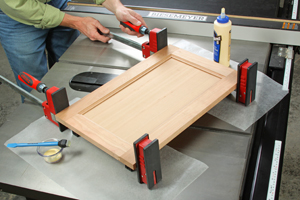
In the past, I have used frame-and-panel construction to produce kitchen cabinets. I used solid cherry for the frames and cherry plywood for the panels. I finished the cabinets with a semi-gloss polyurethane. I did not use any stain but just let the cherry darken naturally. What I discovered is that the solid cherry darkened more than the plywood. I am now building cabinets again for another house. Is there a way to help the solid and plywood cherry to darken to the same degree? – Buzz
Chris Marshall: This sounds like a game of cat-and-mouse, because even if you start by applying a pigment stain or a dyed finish to the raw wood and plywood, the solid cherry is probably still going to darken further than the plywood as it ages. Me? I’d probably make the panels from solid cherry and avoid the mismatch altogether – but that’s not a suitable answer to your good question, Buzz.
Rob Johnstone: Different pieces of cherry will darken at different rates when exposed to the same amount and intensity of sunlight. So the straight-up answer to this question is: you really can’t affect the materials to be certain they will react exactly the same over time. (Even in a single piece of cherry, the reaction can vary across the piece.) One thing a woodworker could do is adjust the color after the darkening process has occurred, at which point you can put a finish with a color (a toner) over the pieces that have darkened as much as the others.
While I don’t recommend it, there are chemicals you can apply to speed up the “aging” process. Potassium dichromate is one — but it is dangerous to use. If you even consider using it, please do your research and take all the safety precautions seriously. Lye is also used — again, it is nasty and caustic. (Did I mention that I don’t think this is a good idea?) Why I do mention this is that, if a woodworker was to darken the wood chemically, then you can use dyes after the fact to match colors of the different pieces, be they plywood or solid cherry. Staining before the darkening occurs can mask the problem, but will not solve it completely.
If I were exceedingly concerned with this problem, I would build the piece of furniture and then let it suntan for a couple of weeks without finish. I could then find out if any of the pieces were troublemakers and adjust their color with a dye. Then I would lightly re-sand and finish the project with a coat of linseed oil, followed my favorite clear finish. There will likely continue to be some differentiation between the pieces composing the project, but the differences will be much less visible, and perhaps even add to the beauty of the piece.





